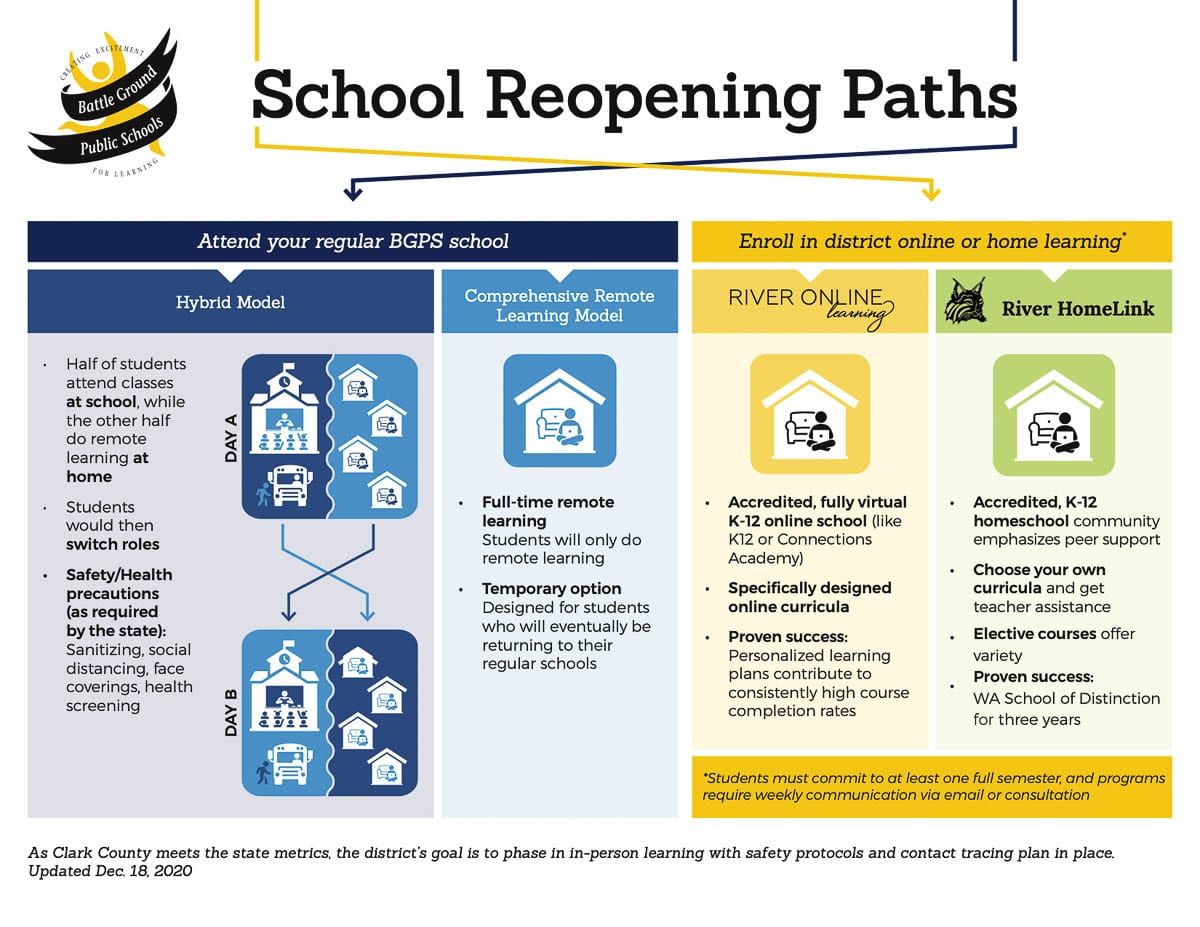District-wide, three-phase process set to begin at the start of February
BATTLE GROUND — As cases of COVID-19 continue to oscillate, school districts like Battle Ground are preparing to implement a phased return to in-person instruction.
Per new Washington State Department of Health (DOH) guidelines for students returning en masse, Battle Ground Public Schools (BGPS) hopes to initiate a month-long period of adjustment before pressing ‘go’ on Feb. 1.
In a special work session on Jan. 4, Superintendent Mark Ross laid out the game plan for school board members as to how the district hopes to proceed. Deputy Superintendent Denny Waters, who will take over for Ross at the end of school year, also helped with the presentation.

“Our recommendation is that we will start pre-K-4 hybrid learning to begin Feb. 1, 2021,” Ross said. “So what that means is that all of our primary schools, preschools, K through four would be starting in a hybrid model, and again, with parents having the option to go to remote beginning Feb. 1.”
DOH has moved away from the tree model of planning for different case number scenarios, and instead has switched to a high, moderate and low leveled chart. At the high level, is a community experiencing more than 350 COVID-19 cases per 100,000 people over two weeks. At this level, DOH states that schools should phase-in pre-K through grade five in a hybrid model.
Stepping down to the moderate category, schools in a community with 50 to 350 cases per 100,000 people over two weeks, are advised to phase-in pre-K through grade five if not already done, and then bring in middle school students.
The third and final tier, or the low level, has schools in areas with fewer than 50 cases per 100,000 people over two weeks implementing in-person instruction for all remaining students. Battle Ground, being in Clark County, has just barely come out of the high category, and thus has only phased in kindergarteners to date.
The basic plan the district has made is to bring in pre-K through fourth grade on Feb. 1, then wait three weeks or if cases fall below the 350 per 100,000 to then bring back middle schoolers; for BGPS grades five through eight. In-person high school instruction would then come three weeks after middle school, or when cases drop below 200 per 100,000 people.

Once in-person instruction resumes, Battle Ground will have a hybrid learning model with all students split into an A group and a B group. On Monday and Tuesday, the A group students will attend class in-person wearing masks and social distancing. On these days B group students will do remote learning. On Wednesday all students will be remote, and on Thursday and Friday the groups will switch.
Parents will also have the opportunity, Ross said, to participate in River HomeLink and River Online Learning; a homeschooling program and online school respectively.
After hearing the district’s plan, members of the school board expressed some disappointment that the start of the phases was not sooner, but did not disagree with the proposed process.
“My concern is that it’s Feb. 1 and not sooner,” said board member Monty Anderson. “The governor came out with these changes on Dec. 18. So we’ve had it for a couple of weeks. And now it’s another month away. What can we do to make it sooner? There’s a lot of concern, both with parents and with staff.”
Ross and Waters, as well as members of the district staff, explained at length the numerous factors preventing a sooner start date, and chiefly among them was the end of Battle Ground’s semester which occurs at the end of January.
This is a time when teachers are hard at work calculating grades and closing the books on curriculum to open new segments. To combine the instant start of a hybrid model with the fast approaching work of the semester end, would be nigh impossible for teachers to navigate successfully, Ross and Waters said.
In addition to the semester, the some three weeks leading up to Feb. 1 are needed to help figure out scheduling and classes as well as which teachers will remain remote and which will return to the classroom in-person; a process determined by health records and seniority.
When it comes to what would be possible when in-person again, Ross and Waters touched on the fact that many activities would still look different. PE class, music, choir, and all large group activities, for example, would be highly modified or restricted, but not impossible, they said.
“I would say flexibility and creativity as well,” Ross said. “As the weather gets nicer, maybe you have choir class outside or band class outside. So certainly there are things we are going to have to think out of the box a little bit to make this hybrid, in-person, you know, a good experience for students and staff.”
The group theorized about the possibility of moving the arbitrary end of the semester to make a more speedy adjustment possible, but concluded the ripple effect in report cards and testing would be too negatively impacted.
“I don’t see a better path with the semester and the time off,” said board member Troy McCoy. “I would like us to have it earlier, but I just don’t see a path.”
After the final completion of a few more elements of the plan, final approval will be issued and the information about the transition will go out to parents. There is currently information regarding remote learning, River Online Learning, River HomeLink, and hybrid-learning on the district website.




